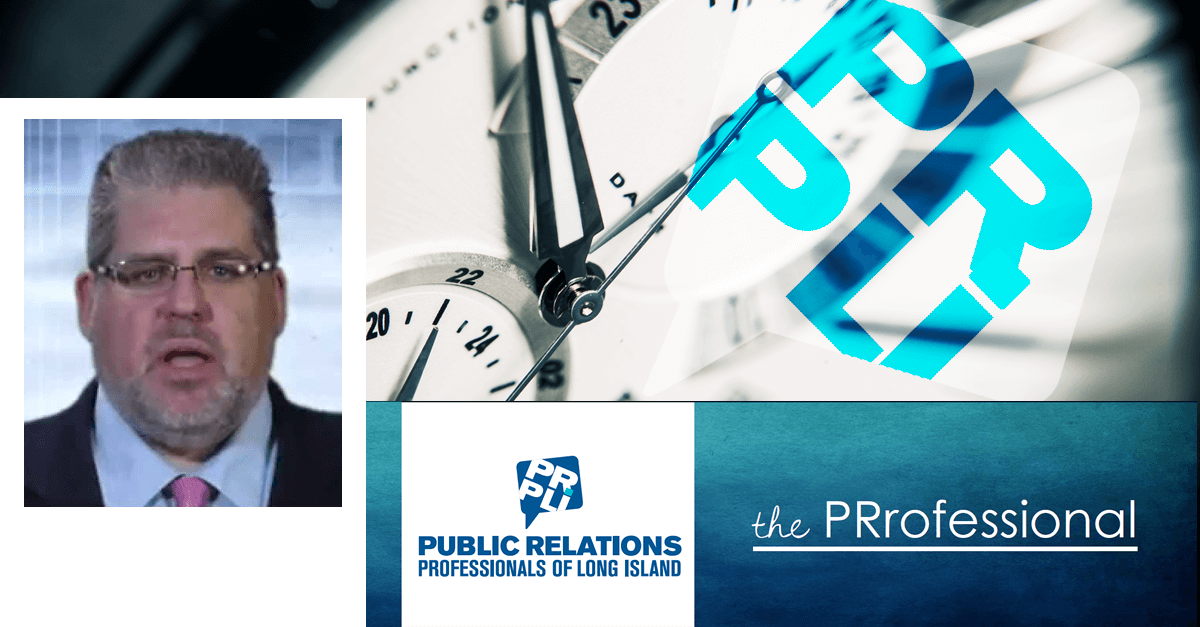By Bill Krol
In the poem To His Coy Mistress, Andrew Marvell tells his lady love that had they all eternity, he could spend centuries extolling her virtues. Alas, though, he doesn’t: “But at my back I always hear/Time’s wingèd chariot hurrying near.”
For today’s PR professional, time’s wingèd chariot is forever hurrying near. We have more on our plates than ever, so it’s crucial to develop tools to help you manage your time effectively.
A quick Google search will return dozens, if not hundreds, of results that offer time management tips. Here are a few that I like.
• Make a to-do list – – Some people use technology – Out- look or Google calendars, or a time management software while others prefer paper to help keep them focused.
I keep a master Word document with current projects and update the list as each project progresses, but I hand- write a to-do list for what I’d like to accomplish that day. Blocking out time in my Outlook calendar doesn’t seem to work for me. For general note taking, I keep an old-fashioned student composition book to avoid loose scraps of paper all over the place. Plus, there’s something satisfying about taking pen in hand to cross off an item on your list. (I confess – sometimes I add an item that I’ve completed just to mark it done.)
Gerrianne Wright, the assistant director for communications for SUNY Plattsburgh, goes old school. “I still use a Day Runner I purchased in 1989,” she says. “I don’t follow to-do lists very well,” she adds, “but they do help me remember.” While some of her colleagues live by their lists, she’s not one of them.
Karen Ulrich Harris, manager of corporate communication at Konica Minolta Business Solutions USA, Inc., uses Google Calendar because it synchs with her iPhone, and she can access multiple calendars. She gave up her Day Runner a long time ago. “I ended up having everything on sticky notes on the pages and then would arrange and rearrange stickies on a daily basis.” But paper isn’t entirely banished: She also uses a desktop blotter-style calendar where she can see everything.
• Prioritize – – If everything’s a priority, nothing’s a priority, so decide which tasks need to be tackled first because of a looming deadline, which can wait because they’re not due yet, which ones can be done “whenever,” and which ones need to be monitored all the time.
Ellen Christie of E.C. Public Relations says that when projects get overwhelming, she creates a “free-minded list with no priorities or amounts of time needed.” Then she labels items “A,” “B,” or “C,” allowing them to naturally determine where they belong. “It’s amazing how uncomplicated things become when items can become ‘C’ items and ‘A’ items rise to the top,” she says.
• Plan your day – – Take time when you get to work in the morning or before you leave for the day and prioritize your tasks. Try to estimate how long certain things will take but allow for flexibility.
Ulrich Harris says, “If you need to deal with a crisis or a deadline, other tasks get pushed off.” She will allocate time for writing, sometimes even booking a conference room to concentrate. Otherwise, she says, “it’s a revolving door of people at my office.” Which brings us to:
• Eliminate distractions – – This one’s a toughie. The chime of an email notification, the chatter of coworkers, the desire to check your social media accounts—all work to keep you from the task at hand. Next time, we’ll look at ways to eliminate distractions during the day so you can focus.
William Krol is the communications manager at the Guide Dog Foundation for the Blind and America’s VetDogs and a freelance copy editor, where he tries to manage his time effectively. He can be reached at wmkrol@yahoo.com.






